Changes in control of saccades during gain adaptation
- PMID: 19091981
- PMCID: PMC2632981
- DOI: 10.1523/JNEUROSCI.3470-08.2008
Changes in control of saccades during gain adaptation
Abstract
In a typical short-term saccadic adaptation protocol, the target moves intrasaccadically either toward (gain-down) or away (gain-up) from initial fixation, causing the saccade to complete with an endpoint error. A central question is how the motor system adapts in response to this error: are the motor commands changed to bring the eyes to a different goal, akin to a remapping of the target, or is adaptation focused on the processes that monitor the ongoing motor commands and correct them midflight, akin to changes that act via internal feedback? Here, we found that, in the gain-down paradigm, the brain learned to produce a smaller amplitude saccade by altering the trajectory of the saccade. The adapted saccades had reduced peak velocities, reduced accelerations, shallower decelerations, and increased durations compared with a control saccade of equal amplitude. These changes were consistent with a change in an internal feedback that acted as a forward model. However, in the gain-up paradigm, the brain learned to produce a larger amplitude saccade with trajectories that were identical with those of control saccades of equal amplitude. Therefore, whereas the gain-down paradigm appeared to induce adaptation via an internal feedback that controlled saccades midflight, the gain-up paradigm induced adaptation primarily via target remapping. Our simulations explained that, for each condition, the specific adaptation produced a saccade that brought the eyes to the target with the smallest motor costs.
Figures
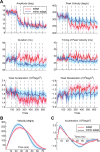
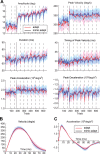
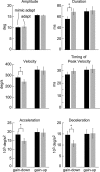
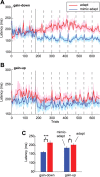
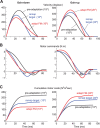
Similar articles
-
Saccadic gain modification: visual error drives motor adaptation.J Neurophysiol. 1998 Nov;80(5):2405-16. doi: 10.1152/jn.1998.80.5.2405. J Neurophysiol. 1998. PMID: 9819252
-
Adaptive control of saccades via internal feedback.J Neurosci. 2008 Mar 12;28(11):2804-13. doi: 10.1523/JNEUROSCI.5300-07.2008. J Neurosci. 2008. PMID: 18337410 Free PMC article.
-
Investigating the site of human saccadic adaptation with express and targeting saccades.Exp Brain Res. 2002 Jun;144(4):538-48. doi: 10.1007/s00221-002-1077-x. Epub 2002 Apr 23. Exp Brain Res. 2002. PMID: 12037638
-
Sensorimotor adaptation of saccadic eye movements.Neurosci Biobehav Rev. 2010 Jul;34(8):1103-20. doi: 10.1016/j.neubiorev.2009.12.010. Epub 2009 Dec 22. Neurosci Biobehav Rev. 2010. PMID: 20026351 Review.
-
How cerebellar motor learning keeps saccades accurate.J Neurophysiol. 2019 Jun 1;121(6):2153-2162. doi: 10.1152/jn.00781.2018. Epub 2019 Apr 17. J Neurophysiol. 2019. PMID: 30995136 Free PMC article. Review.
Cited by
-
The influence of action on perception spans different effectors.Front Syst Neurosci. 2023 May 2;17:1145643. doi: 10.3389/fnsys.2023.1145643. eCollection 2023. Front Syst Neurosci. 2023. PMID: 37205054 Free PMC article. Review.
-
Oculomotor Adaptation Elicited By Intra-Saccadic Visual Stimulation: Time-Course of Efficient Visual Target Perturbation.Front Hum Neurosci. 2016 Mar 9;10:91. doi: 10.3389/fnhum.2016.00091. eCollection 2016. Front Hum Neurosci. 2016. PMID: 27014023 Free PMC article.
-
End-point variability is not noise in saccade adaptation.PLoS One. 2013;8(3):e59731. doi: 10.1371/journal.pone.0059731. Epub 2013 Mar 21. PLoS One. 2013. PMID: 23555763 Free PMC article.
-
Trial-to-trial adaptation in control of arm reaching and standing posture.J Neurophysiol. 2016 Dec 1;116(6):2936-2949. doi: 10.1152/jn.00537.2016. Epub 2016 Sep 28. J Neurophysiol. 2016. PMID: 27683888 Free PMC article.
-
A comparison of the temporal and spatial properties of trans-saccadic perceptual recalibration and saccadic adaptation.J Vis. 2020 Apr 9;20(4):2. doi: 10.1167/jov.20.4.2. J Vis. 2020. PMID: 32271892 Free PMC article.
References
-
- Collins T, Semroud A, Orriols E, Dore-Mazars K. Saccade dynamics before, during and after saccade adapation in humans. Invest Opthalmol Vis Sci. 2008;49:604–612. - PubMed
Publication types
MeSH terms
Grants and funding
LinkOut - more resources
Full Text Sources
